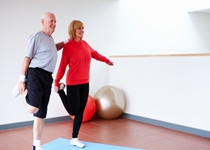 You could be at risk for a severe injury and not even know it. It could happen the moment you finish this article, walk to the kitchen for a snack, or when you’re climbing into bed tonight. At any given time, you could take a serious fall. And even though it might sound outlandish, falling is becoming an increasing concern for Americans, as it can, in some cases, result in death. Luckily, there are ways you can protect yourself.
You could be at risk for a severe injury and not even know it. It could happen the moment you finish this article, walk to the kitchen for a snack, or when you’re climbing into bed tonight. At any given time, you could take a serious fall. And even though it might sound outlandish, falling is becoming an increasing concern for Americans, as it can, in some cases, result in death. Luckily, there are ways you can protect yourself.
Study Reports Falls Among Americans Seniors on the Rise
A recent study has shown that self-reported falls among American seniors is on the rise, with an eight-percent increase over a 12-year span. The University of Michigan analysis looked at data from 1998 to 2010 among adults who were 65 and over and saw the instance of self-reported falls jump from 28% to 36% over that time period. This number is expected to rise as there are more 80- and 90-year-olds than ever before. But surprisingly, the statistics saw increases in falls across the board, not just in the oldest portion of the demographic. That means that it doesn’t really matter if you’re 65 or 95—you’re at the same risk for a fall.
Falls are the most common cause of injury among older adults, with about a third of that demographic taking a fall each year. It’s a problem that could have a number of outcomes, some inconsequential and others causing major injuries.
Protecting Yourself from a Fall
Falls can literally happen anywhere, at any time. A 33-year-old friend of mine fell the other day, while boarding the subway; I’ve fallen just walking down the street. The point is that no matter who you are, how old you are, or what kind of health you’re in, the risk is always there.
The only real ways to protect yourself from a fall are to work on balance, be aware of your environment, and limit the risk around your home. The more you can control your environment, the better chance you have of avoiding a potentially serious injury.
The National Council on Aging has set up a program called “Matter of Balance,” which emphasizes the importance of strength, awareness, and balance to help lower the risk of falls. So far, its theory and approach are producing positive results. Participants in the program have learned to accept that they can control their environment to limit their risks, and they’ve managed to reduce frequency of falls and improve mobility.
One of the biggest reasons you fall is because you have a hard time getting around. However, by increasing activity levels and doing some strength training, you can really reduce the risk. I know it seems counterintuitive. If people fall when they get up, shouldn’t they spend more time sitting down, out of harm’s way? Absolutely not!
When you’re active, you strengthen your muscles and can have increased intuition about your surroundings—in other words, you’re more comfortable on your feet. In addition, when you are active and do some light strength training, your muscles, bones, and joints become stronger and more durable. This increases the likelihood you’ll catch your balance, or at least be better prepared to handle any impact from bumps. The more muscle you have and the more limber you are (achieved through activity and exercise), the better protected you are in the case of a fall.
Strengthening for Balance: Three Exercises to Prevent Falls
You can work on strength by performing exercises throughout the week that encourage balance. Some good ones to try are:
-
Toe Stand
Hold onto something for support, and stand with your back straight and your knees slightly bent. Push up on your tiptoes as far as possible to engage your calves. Hold this position for a couple of seconds, and then slowly bring your heels down. Repeat this motion 10–20 times.
-
Knee Curl
Hold onto the back of a chair (or something else that’s stable and can support your weight) for balance. Stand up straight with your knees slightly bent and your feet about shoulder-width apart. Lift one of your legs straight behind you, and then bend your knee to bring your heel towards your butt. Slowly lower it back to the starting position and repeat the motion about 10–20 times for each leg.
-
Leg Extension
Sit on a chair with a straight back that allows your feet to touch the floor. Bring one leg up and straighten it in front of you, keeping your back on the chair. Be careful not to use momentum because you don’t want to fall backwards—by focusing on the thigh muscles, you’ll be able to eliminate momentum. Bring your foot back to the floor and repeat 10–20 times for each leg.
You can also improve balance by doing things like standing on one leg, and sitting down then standing up without using your hands.
It Might Be Time for Some Renovations
Another way to reduce the risk of a fall is to make your home a place where a fall is unlikely to occur. No, you can’t completely eliminate the risk, but you can lower it by making it an easier landscape through which to navigate. Invite somebody over to help you clear clutter, create open pathways, and be sure to do little things like put items away after you’ve used them. The more things you have out, the more likely you are to bang into them or slip on them. By limiting the hazard, you can lower your chances of injury. If you must, move your bedroom to the main floor of your home or even consider moving to an apartment, condo, or one-story home that is easier to maneuver through.
Falling is a growing concern and the numbers back this up. Do what you can to protect yourself from this epidemic by strengthening your muscles, improving your balance, and decluttering your living space—giving yourself the best chance at preventing serious injury.
Sources for Today’s Article:
“Center for Healthy Aging; A Matter of Balance,” National Council on Aging web site, http://www.ncoa.org/improve-health/center-for-healthy-aging/a-matter-of-balance.html, last accessed February 3, 2015.
Lanagan, M., “Exercises to Help Prevent Falls,” MedlinePlus web site, June 30, 2014; http://www.nlm.nih.gov/medlineplus/ency/patientinstructions/000493.htm, last accessed February 3, 2015.
University of Michigan Health System, “Study suggests increase in falls among the elderly,” ScienceDaily web site, January 19, 2015; http://www.sciencedaily.com/releases/2015/01/150119124516.htm.
